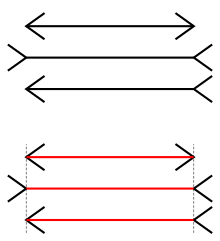Müller-Lyer illusion
The Müller-Lyer illusion , also known as the Müller-Lyer illusion , is a very well-known geometrical- optical illusion . It was discovered in 1889 by the German psychiatrist and sociologist Franz Müller-Lyer (1857-1916).
The phenomenon: A horizontal line is enclosed between two angles, the tips of which coincide with the ends of the line. If the tips point outwards, the line appears significantly shorter than if the arrowheads point inwards. To this day there is no unanimous explanation for this deception.
- One explanatory approach justifies the phenomenon with Emmert's law .
- Poor coordination between the brain and eyes is another possible explanation for the deception.
- Another explanation is that the constructs are unconsciously interpreted as spatial objects, for example as a bulged or constricted vessel, with the center lines unconsciously being approximated to the lengths of the upper and lower edges.
- The deception can also be interpreted as a context effect in which the perceived length of the line interacts with the subjectively perceived distance between the arrows. The arrows with the angles they enclose form sources of increased geometric information that attract attention. However, the distance between these centers of information does not have to exactly match the length of the line, even if the arrowheads coincide with the ends of the line. This discrepancy essentially depends on whether the arrows extend outwards or inwards from the line ends, i.e. point towards the center of the line or away from it, and also on the shape of the arrows. Since line and arrows also form a perceptual unit (if they are directly adjacent to each other or overlap), they can influence each other's perception. This influence becomes clear when you dissolve this unit: In the picture on the right, the line with the immediately adjoining, inwardly directed peaks (top) appears longer than when gaps are left and the target can largely be viewed on its own (center). It appears even shorter when the arrows move towards the center and the distance between the information centers is significantly smaller than the length of the line. One way to test one's own ability to estimate line length is found in Bach.
In 2010, the evolutionary scientist Joseph Henrich and his colleagues showed in a cross-cultural study that the deception only occurs in people whose everyday life even includes straight lines. For people of the San people the delusion does not exist and for many other groups around the world the effect is minimal. The deception is perceived most strongly by people from western cultures.
Individual evidence
- ↑ Franz Müller-Lyer: Optical judgment illusions. Archives for Physiology Suppl. 263–270, 1889.
- ^ B. Lingelbach: The Müller-Lyer deception. 2013.
- ^ Inga Menkhoff: The world of optical illusions, Parragon Books Ltd., pp. 14 and 15.
- ↑ WA Kreiner: Ingoing versus outgoing wings. The Müller-Lyer and the mirrored triangle illusion. 2012. doi : 10.18725 / OPARU-2594
- ↑ M. Bach: Müller-Lyer deception.
- ↑ Thomas Widlok, Niclas Burenhult: See, smell, orient . Spectrum of Science, July 2014, p. 78.

